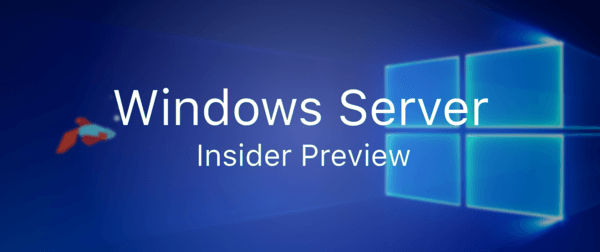Microsoft today released a new Insider Preview of Windows Server. This time it is Windows Server Build 17639. Officially known as Windows Server 2019, this release is now available for the Long-Term Servicing Channel (LTSC).
Advertisеment
 The Insider Preview program for Windows Server allows customers to try out all the new features of the upcoming OS and provide feedback on them to Microsoft. Here is the change log for Windows Server 2019 Build 17639.
The Insider Preview program for Windows Server allows customers to try out all the new features of the upcoming OS and provide feedback on them to Microsoft. Here is the change log for Windows Server 2019 Build 17639.In-place upgrades
In-place upgrade allows an administrator to upgrade an existing installation of Windows Server to a newer version, retaining settings and installed features. The LTSC versions and editions of Windows Server that are supported for in-place upgrade are shown in the following table.
CURRENTLY INSTALLED OPERATING SYSTEM AVAILABLE UPGRADE VERSION & EDITION Windows Server 2016 Standard Windows Server 2019 Standard or Datacenter Windows Server 2016 Datacenter Windows Server 2019 Datacenter Windows Server 2012 R2 Standard Windows Server 2019 R2 Standard or Datacenter Windows Server 2012 R2 Datacenter Windows Server 2019 R2 Datacenter Storage Migration Service
A common issue around Windows Server is a lack of data migration options from older operating systems and storage platforms. Simply because in-place upgrades were impossible, and because manual migrations are slow and likely to cause significant interruptions to service or loss of access for users and applications, many customers are still using Windows Server 2012 R2, Windows Server 2008 R2, and even Windows Server 2003.
Addressing this challenge, Windows Server 2019 introduces the Storage Migration Service (SMS), a new role included in Windows Server Standard and Datacenter editions. SMS is a job-based orchestration and proxy that:
- Allows administrators to inventory existing servers for their data, security, and network settings.
- Migrates that data, security, and network settings to a new, modern target by using the SMB protocol.
- Takes over the identity of the old server completely, while decommissioning the original source, in such a way that users and applications are unaffected and unaware that migration has taken place.
SMS provides orchestrated workflow with a Honolulu-based graphical management system, allowing scalable migrations of many servers simultaneously to new targets running on premises or in Azure.
SMS handles common problems and subtleties of a migration, including in-use files, share settings, security settings, network addresses and names, local security principals, encrypted data, and more. All of this is available from an intuitive graphical interface, which is backed by robust PowerShell automation.
SMS is under active development, and you will see many changes and improvements with each preview. Furthermore, the use of the Honolulu management system enables out-of-band changes through its extension manager system, allowing us to act on your feedback more frequently than the Windows Server preview mechanism allows.
Storage Replica
Storage Replica (SR) was first released as a technology for Windows Server 2016 Datacenter Edition. SR enables synchronous and asynchronous block replication of volumes between servers or clusters for disaster recovery. SR also enables you to create stretch failover clusters that span two sites, with all nodes staying in sync.
Beginning with Windows Server 2019, responding to customer requests, we’ve added the following improvements to SR:
- Log v1.1. Performance improvements to the SR log system lead to far better replication throughput and latency, especially on all-flash arrays and Storage Spaces Direct (S2D) clusters that replicate between each other. To take advantage of this update, you must upgrade all servers participating in replication to Windows Server 2019.
- Test Failover. It is now possible to mount a writable snapshot of replicated destination storage. To do so, your server must have an unused volume that is not currently replicating on the destination; on the unused volume, temporarily mount a snapshot of the replicated storage for testing or backup purposes. Replication of the original source continues unabated while you perform your tests; your data is never unprotected and your snapshot changes will not overwrite it. When you are done, discard the snapshot. (Note: We first released this feature in the Windows Server version 1709 channel).
- Storage Replica Standard. SR will soon be available on Windows Server 2019 Standard Edition, not just on Datacenter Edition. When installed on servers running Standard Edition, SR has the following limitations:
SR replicates a single volume (instead of an unlimited number of volumes).
Volumes can have one partnership (instead of an unlimited number of partners). Volumes can have a size of up to 2 TB (instead of an unlimited size).
We will continue to listen to your feedback and evaluate these settings through our telemetry during Insider previews of Windows Server 2019. These limitations may change several times during the preview phase and at RTM.
This build will expire July 2nd, 2018.
Learn more about issues and bugs in the official announcement.
You can download Windows Server Insider Preview here:
Download Windows Server Insider Preview
Support us
Winaero greatly relies on your support. You can help the site keep bringing you interesting and useful content and software by using these options:
